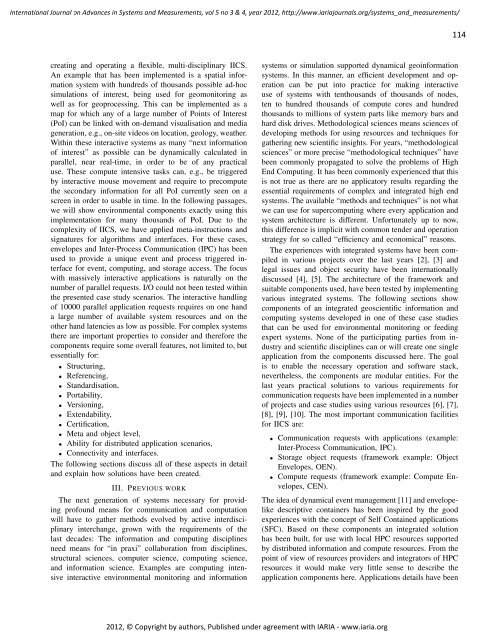c - IARIA Journals
c - IARIA Journals
c - IARIA Journals
Create successful ePaper yourself
Turn your PDF publications into a flip-book with our unique Google optimized e-Paper software.
International Journal on Advances in Systems and Measurements, vol 5 no 3 & 4, year 2012, http://www.iariajournals.org/systems_and_measurements/<br />
creating and operating a flexible, multi-disciplinary IICS.<br />
An example that has been implemented is a spatial information<br />
system with hundreds of thousands possible ad-hoc<br />
simulations of interest, being used for geomonitoring as<br />
well as for geoprocessing. This can be implemented as a<br />
map for which any of a large number of Points of Interest<br />
(PoI) can be linked with on-demand visualisation and media<br />
generation, e.g., on-site videos on location, geology, weather.<br />
Within these interactive systems as many “next information<br />
of interest” as possible can be dynamically calculated in<br />
parallel, near real-time, in order to be of any practical<br />
use. These compute intensive tasks can, e.g., be triggered<br />
by interactive mouse movement and require to precompute<br />
the secondary information for all PoI currently seen on a<br />
screen in order to usable in time. In the following passages,<br />
we will show environmental components exactly using this<br />
implementation for many thousands of PoI. Due to the<br />
complexity of IICS, we have applied meta-instructions and<br />
signatures for algorithms and interfaces. For these cases,<br />
envelopes and Inter-Process Communication (IPC) has been<br />
used to provide a unique event and process triggered interface<br />
for event, computing, and storage access. The focus<br />
with massively interactive applications is naturally on the<br />
number of parallel requests. I/O could not been tested within<br />
the presented case study scenarios. The interactive handling<br />
of 10000 parallel application requests requires on one hand<br />
a large number of available system resources and on the<br />
other hand latencies as low as possible. For complex systems<br />
there are important properties to consider and therefore the<br />
components require some overall features, not limited to, but<br />
essentially for:<br />
• Structuring,<br />
• Referencing,<br />
• Standardisation,<br />
• Portability,<br />
• Versioning,<br />
• Extendability,<br />
• Certification,<br />
• Meta and object level,<br />
• Ability for distributed application scenarios,<br />
• Connectivity and interfaces.<br />
The following sections discuss all of these aspects in detail<br />
and explain how solutions have been created.<br />
III. PREVIOUS WORK<br />
The next generation of systems necessary for providing<br />
profound means for communication and computation<br />
will have to gather methods evolved by active interdisciplinary<br />
interchange, grown with the requirements of the<br />
last decades: The information and computing disciplines<br />
need means for “in praxi” collaboration from disciplines,<br />
structural sciences, computer science, computing science,<br />
and information science. Examples are computing intensive<br />
interactive environmental monitoring and information<br />
systems or simulation supported dynamical geoinformation<br />
systems. In this manner, an efficient development and operation<br />
can be put into practice for making interactive<br />
use of systems with tenthousands of thousands of nodes,<br />
ten to hundred thousands of compute cores and hundred<br />
thousands to millions of system parts like memory bars and<br />
hard disk drives. Methodological sciences means sciences of<br />
developing methods for using resources and techniques for<br />
gathering new scientific insights. For years, “methodological<br />
sciences” or more precise “methodological techniques” have<br />
been commonly propagated to solve the problems of High<br />
End Computing. It has been commonly experienced that this<br />
is not true as there are no applicatory results regarding the<br />
essential requirements of complex and integrated high end<br />
systems. The available “methods and techniques” is not what<br />
we can use for supercomputing where every application and<br />
system architecture is different. Unfortunately up to now,<br />
this difference is implicit with common tender and operation<br />
strategy for so called “efficiency and economical” reasons.<br />
The experiences with integrated systems have been compiled<br />
in various projects over the last years [2], [3] and<br />
legal issues and object security have been internationally<br />
discussed [4], [5]. The architecture of the framework and<br />
suitable components used, have been tested by implementing<br />
various integrated systems. The following sections show<br />
components of an integrated geoscientific information and<br />
computing systems developed in one of these case studies<br />
that can be used for environmental monitoring or feeding<br />
expert systems. None of the participating parties from industry<br />
and scientific disciplines can or will create one single<br />
application from the components discussed here. The goal<br />
is to enable the necessary operation and software stack,<br />
nevertheless, the components are modular entities. For the<br />
last years practical solutions to various requirements for<br />
communication requests have been implemented in a number<br />
of projects and case studies using various resources [6], [7],<br />
[8], [9], [10]. The most important communication facilities<br />
for IICS are:<br />
• Communication requests with applications (example:<br />
Inter-Process Communication, IPC).<br />
• Storage object requests (framework example: Object<br />
Envelopes, OEN).<br />
• Compute requests (framework example: Compute Envelopes,<br />
CEN).<br />
The idea of dynamical event management [11] and envelopelike<br />
descriptive containers has been inspired by the good<br />
experiences with the concept of Self Contained applications<br />
(SFC). Based on these components an integrated solution<br />
has been built, for use with local HPC resources supported<br />
by distributed information and compute resources. From the<br />
point of view of resources providers and integrators of HPC<br />
resources it would make very little sense to describe the<br />
application components here. Applications details have been<br />
2012, © Copyright by authors, Published under agreement with <strong>IARIA</strong> - www.iaria.org<br />
114







